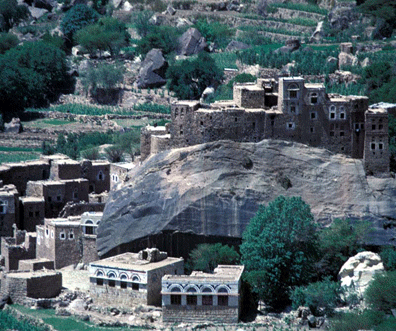
Hamlet of Mais in central Yemen; entrance is carved through the large rock.
Photograph by Daniel Martin Varisco
By: Khaled Fattah, Yemen Times
Outside observers of Yemen’s social and political life can not avoid noticing many conceptual puzzles and precious particularities. One of the widely known puzzles among researchers with political science background is the surprising fact that although Yemen is the least developed and weakest Arab state that governs a society characterized by fierce tribal traditions and structures, it’s a country with a party pluralism system. Precious particularities of Yemen, on the other hand, are numerous. To begin with, there is a coincidence of almost everything- from geographical and topographical destiny to the patterns of habitation and concentration of sects; and from the shades of experienced ideologies and insecurity of economic resources to the peculiar nature of colonialism and regional power interventions. This sharp multifaceted coincidence is not something of the past. Rather, it is being felt in every bone in the political, economic and socio-cultural skeletons of today’s fragile Yemen.
Here is an interesting example of such a coincidence: The Shiite Zaydis who comprise approximately 30 to 40% of the Yemeni nation have traditionally been concentrated in the rugged mountainous northern areas and in the drier flatter eastern sections of the country. In such an ecological context, pastoralism rather than farming dominated the socio-economic life. As a result, Zaydis have generally been organized along tribal patterns rather than sedentary ones. For more than a millennium, tribes in this inhospitable terrain constituted the military backbone for the string of successive despotic imams.
Despite their religiously-based support to the Imams, however, tribes have often resisted any attempt from the Imams to impose their central authority and direct control.
For most of its history, the Zaydi theocratic state was weakly centralized, revolved around the personality of the imam, and were in no position to combat powerful tribal structures. There is, actually, a wide agreement among historians of Yemen that the salient feature of any Yemeni central authority, even long before the Imamate dynasty, has been its limited capacity to penetrate and directly regulate tribes in the mountainous northern areas. The topography of this part of Yemen has prevented any kind of single centralized control. Interestingly, it has also prevented state authoritarianism from flourishing as it did in the rest of the Arab Middle East.
The Sunni Shafis, on the other hand, who constitute the major community in Yemen, dominate the Southern highlands and coastal areas, which receive abundant monsoon rainfall. Such geographical locations made the socio-economic life of the Sunni Shafis characterized by sedentary farming and commercial tradition. Indeed, throughout the history of Yemen most of the trading activities with the outside world were channeled through the largely Shafi cities of Aden and Ta’iz. As a result, Sunni Shafis were more outward-looking, and had a high rate of emigration than the Shiite Zyadis in former North Yemen. This sectarian and mode of production division has created, over time, two different societies within Yemen.
The second significant particularity is the fact that North Yemen, unlike almost all entities of the developing world, never came under European colonization. This means it did not inherit colonial infrastructure, and had the least contact with the Western world. The third particularity of interest is the one related to concentration of authority and power. Few centuries ago, a Danish botanist made a scientific expedition to Egypt and Yemen and noted the following: “The Arab Yemen is different from the Arab Egypt; here the noble live far from the centersâ€. This observation by a botanist is politically valid in most of Yemen’s ancient and modern history. The Yemeni elites have always been widely dispersed and often beyond any central control. Even in today’s Yemen, in a sharp contrast to the rest of the region, authority and influence are concentrated much more around houses of powerful tribal Sheikhs than around government buildings.
Bearing in mind that Yemen is an ancient society, which is governed by a newly established modern state system, such ecological, topographical and socio-psychological divisions continue to feed the tense relationship between tribal, regional and national identities. Each of these identities requires loyalties of its members, each represents alternative institutions of power and social control, and each enables actors to create not only overlapping social meanings but also multiple vehicles for political and economic demands. The latter usually become louder and more intense at times of national crises, and may pose a serious threat to public order when it takes a non-peaceful form. To remove or at least reduce the friction that is generated by the push-pull forces of sectarian, regional, tribal and national identities, it is crucial for Yemen’s decision makers to adopt, without delay, politics of citizenship and inclusion.
Khaled Fattah is a Doctoral Candidate at the University of St Andrews